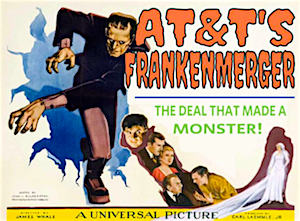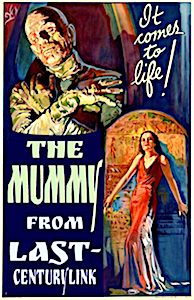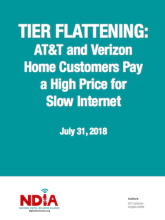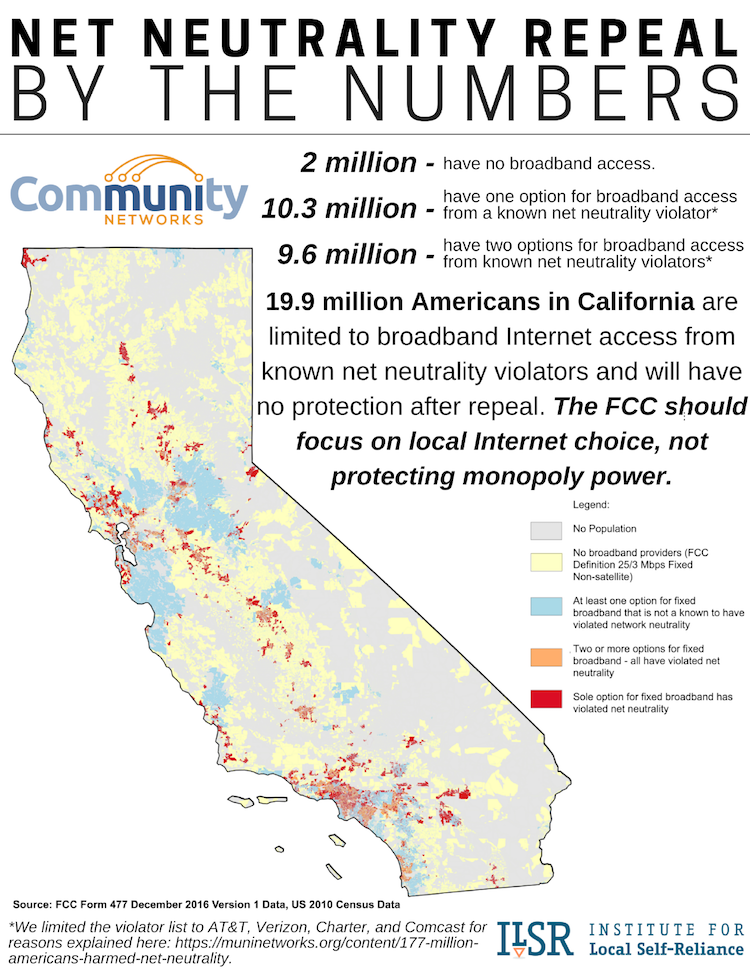
Fast, affordable Internet access for all.

Almost six years ago, we told readers about Ottawa, Kansas, where the community of around 13,000 people had invested in publicly owned fiber optic connectivity for local businesses. We recently touched base with IT Director Paul Sommer, who updated us on the progress of their broadband utility and how it has impacted the community.
Steady as it Grows
When we first met Ottawa, they had worked with the local school district and Franklin County to capitalize on existing fiber infrastructure and expand to more locations. Local leaders had learned from Ottawa businesses that the best options available from incumbent AT&T were T1 lines for approximately $600. Higher capacity connections were scarce and financially out of reach for local establishments, and AT&T could not be convinced to upgrade their infrastructure. As Bigham put it, AT&T was "milking the cow."
Once the city, school district, and Franklin County established a partnership, Ottawa began to expand fiber to other municipal facilities and businesses as requested. Sommers, who has taken over as IT Director, says that now all 10 city buildings are on the network. In addition to an industrial park on the original infrastructure on the north end of town, the network now reaches an industrial park to the south.
The electric utility has trained their own staff rather than hiring external fiber deployment personnel. In addition to enriching skills, their employees are able to respond quickly if there are downed cables or other maintenance issues. Sommers recalls an instance when a car, which had caught fire, sent shrapnel flying into the air. By a twist of fate, one piece severed the fiber optic cable hanging some distance away. His team was able to rehang and splice the cable that same day and get the subscriber back online.
By using electric utility staff, Ottawa has reduced the cost of their incremental build over the years. They typically budget around $100,000 each year for expansion of the network, have never gone over, and often don’t spend the entire allotment. Sommers says that, since they own the utility poles in town, have necessary personnel on hand, and equipment at the ready, unnecessary bureaucracy doesn’t slow down maintenance, repairs, or expansion efforts.
Bursting at the Streams
As the seasons change, we're fondly remembering past team members from the Community Broadband Networks Initiative and their creative contributions to our Halloween stories. Scott, Kate, and Hannah have moved on to other paths in their careers, but we'll always treasure their contribution to our 2016 celebration of movie monster madness. A special hat tip to our Development Director John Bailey, who pointed out this Halloween morning that "Munis are 'ghoul!'" Check it out:
Much like the the bone-chilling flicks celebrating eerie entertainment that dwells in the depths of our dark imaginations, monster cable and DSL Internet service providers strike terror in the hearts of subscribers…if they survive. Mesmerizing fees, hair-raising customer service, and shockingly slow connections can drive one to the brink of madness.
In celebration of Halloween 2016, our writers each selected a national ISP and reimagined it as a classic horror character. The results are horrifying! Read them here…if you dare!
AT&T’s Frankenmerger

by Kate
This shocking film tells the horrific tale of a mad scientist in his quest to create the world’s largest telecommunications monopoly monster. The scientist’s abomination runs amok, gobbling up company after company, to create a horrifying monster conglomerate. Watch the monster terrorize towns across America as it imposes data caps, denies people access to low-cost programs, and refuses to upgrade infrastructure. What nightmare lies ahead? Will the townsfolk and their elected officials unite to stop the monster, before it acquires Time Warner? Watch and find out!

The Mummy From Last CenturyLink
by Scott
The fifth anniversary of the announcement of the KentuckyWired project is approaching later this year. As voters start to assess their candidates’ job performance, the unfinished and over budget middle mile public-private partnership (P3) has become an albatross that incumbents aren’t able to easily cast off. When we last discussed the project in 2017, we shared our observations and misgivings. Not much has changed, except some of our concerns have played out and the project has become troubled by new problems.
In Case You’re Just Arriving to the Party…
The statewide, massive middle mile project officially began when Kentucky announced in late 2014 that they would build a fiber optic network in order to bring better connectivity to rural areas. They planned to find a private sector partner and sought bids. In the fall of 2015, Australian firm Macquarie won the contract for what soon became an even larger endeavor — a fiber optic network that would enter every county in the state at a minimum of one location. The network would consist of approximately 3,200 miles of fiber and connect about 1,000 public facilities. At the time the project was developed, the state estimated that deployment would cost approximately $300 million.
With early bipartisan support, the state allocated $30 million from their budget, which they expected to combine with $23.5 million in federal grants. When the Kentucky Economic Development Finance Authority issued $232 million in tax-exempt revenue bonds and $58 million in taxable revenue bonds to complete financing, Bond Buyer named the issue the “Deal of the Year” for 2015. Macquarie’s timeline estimated an optimistic one-year completion for the entire statewide project.
People in Lampasas are fed up with outages that have repeatedly plagued the community due to lack of redundant infrastructure connecting the central Texas municipality. Now, the city and the Lampasas Economic Development Corporation (LEDC) are asking the community to complete an Internet survey to help determine how best to move forward an achieve better connectivity.
Cuts to the Line
In the spring, summer, and early fall of 2017, Lampasas experienced four outages totaling 45 hours when local construction projects accidentally cut AT&T fiber, the only Internet connection into town. Without a redundant line, the community’s residents, businesses, emergency services, and hospitals were cut off for days as AT&T repaired the breaks. To add insult to injury, AT&T didn’t respond well to the town’s requests to resolve the situation:
“We felt like we weren't a priority on AT&T's list, so when we had outages, and we had businesses that were losing thousands of dollars, and we were calling and we were trying to get reimbursements, and we were trying to get answers, and we were trying to see if there were future projects for infrastructure for Lampasas, we just weren't getting a good response from AT&T,” Lampasas Economic Development Director Mandy Walsh said.
Within a few months, local leaders had started searching for a firm to help them assess their options. After considering proposals from six different companies, Lampasas chose Foresite Group for a project that includes a market analysis and a technology assessment. As part of the project, Foresite Group has helped the city and the LEDC prepare the current survey.
The survey has divided the community into Service Zones in order to obtain a detailed analysis of which areas of town residents and businesses are most interested in better Internet access. The Service Zones approach will also help the city, the EDC and Foresite discover Internet access speeds in each area of town.

In recent years AT&T and Verizon, the nation’s two largest telco Internet providers, have eliminated their cheaper rate tiers for low and mid-speed Internet access, except at the very slowest levels. Each company now charges essentially identical monthly prices – $63-$65 a month after first year discounts have ended – for home wireline broadband connections at almost any speed up to 100/100 Mbps fiber service.
This policy of upward “tier flattening” raises the cost of Internet access for urban and rural AT&T and Verizon customers who only have access to the oldest, slowest legacy infrastructure.
Affordability is the greatest barrier to increased home broadband subscriptions. In the United States, broadband is becoming faster for some households and more expensive for others.
This report from the National Digital Inclusion Alliance (NDIA) takes a detailed look at tier flattening from AT&T and Verizon, digging into monthly rates that users pay and the types of services they obtain from each company. The authors put the numbers side by side and show that those purchasing what used to be the most economical Internet access service are now simply paying higher rates for slow service.
Download the report to see the comparisons and the authors' analysis.
For years, national cable and telecom companies have complained that they work in a tough industry because “there’s too much broadband competition.” Such a subjective statement has created confusion among subscribers, policy makers, and elected officials. Many people, especially those in rural areas, have little or no choice. We wanted to dive deeper into the realities of their claim, so we decided to look at the data and map out what the large carriers offer and where they offer it. In order to share our findings with policy makers, local elected officials, and the general public, we’ve created a report that includes series of maps to illustrate our findings and our analysis, Profiles of Monopoly: Big Cable and Telecom.
Choice: The Ultimate Prize
Whether it’s a brand of breakfast cereal, a model of car, or an Internet Service Provider (ISP), those who purchase a good or service know that when they have more options, the options they have are better. The FCC defines "broadband" as connectivity that provides speeds of at least 25 Megabits per second (Mbps) download and 3 Mbps upload; our report fouces on service where ISPs claim to offer this minimum threshold.
When it comes to ISPs, subscribers often have a faux choice between unequal services, such as one telephone company offering slow DSL and one cable company that offers faster cable Internet access. People in rural America often have even slimmer options because cable ISPs don’t provide broadband in less populated rural areas. In other words, the market has spoken and the market is broken.

Early last year, Connect Your Community and the National Digital Inclusion Alliance released a well-researched and compelling case that AT&T had engaged in digital redlining of Cleveland, refusing to upgrade Internet access to neighborhoods with high poverty rates. In episode 290 of the Community Broadband Bits podcast, we check in to learn more and discuss key lessons.
Angela Siefer, executive director of NDIA, and Bill Callahan, President and Director of Connect Your Community in Cleveland, explore what is happening both in Cleveland and other metro centers where low-income residents are often over-paying for services far slower than are available in higher-income neighborhoods.
This discussion covers important ground, not just describing the problem but discussing how the easiest solution (forcing AT&T to upgrade areas it has neglected) is not sufficient. Also, there is sports talk at the beginning but then the host gets himself under control and focuses on what is important in this conversation.
This show is 35 minutes long and can be played on this page or via Apple Podcasts or the tool of your choice using this feed.
Transcript below.
We want your feedback and suggestions for the show-please e-mail us or leave a comment below.
Listen to other episodes here or view all episodes in our index. See other podcasts from the Institute for Local Self-Reliance here.
Thanks to Arne Huseby for the music. The song is Warm Duck Shuffle and is licensed under a Creative Commons Attribution (3.0) license.
Most residents and businesses in Oconee County, South Carolina, used dial-up connections when county officials applied for stimulus funding in 2010; there were still people in the county with no Internet access at all. A few had DSL connections, but even county facilities struggled with antiquated infrastructure. After an AT&T attack upended their plan to offer retail services, they pressed on and improved connectivity in the rural community. Powerful incumbent forces and a bad state law, however, eventually led this community to choose privatization.
Ripe For Stimulus
We spoke with Kim Wilbanks, who served as Project Manager for Oconee FOCUS, the 240-mile fiber optic publicly owned network. She worked with a small team of people that applied for funding through the American Recovery and Reinvestment Act (ARRA) to obtain funds for the project. Wilbanks and former FOCUS Director Mike Powell were instrumental in establishing the infrastructure. The Wilbanks family used dial-up Internet access until 2010 when AT&T finally installed DSL on her street on the edge of town in the mostly rural county.
The mountains and hills across the county’s 674 square miles create a terrain that is speckled with man-made lakes. Fishing, water skiing, and sailing are popular and the lakes and waterfalls contribute to the region’s hydroelectric energy. Approximately 75,000 people live in Oconee County scattered within many of the small rural communities. The largest city’s population is only about 8,000.
On December 14th, FCC Chair Ajit Pai and the Republican Commissioners voted to present a huge holiday gift to big ISPs by dismantling network neutrality, despite outcries from the American people. When we examined FCC data to determine how many Americans would be left without market protections from known network neutrality violators, the numbers were discouraging. Now we’ve reached into the weeds to analyze the numbers on a statewide basis.
Percentage Of Population
The results reveal that a significant percentage of Americans will be limited to Internet access only from large monopolies that have a history of violating network neutrality and very strong incentives to abuse their market power.
Some states with higher population benefit slightly from competition relative to others — compare Florida’s 40 percent to 65 percent in Pennsylvania — but this also reflects the anti-competitive nature of big ISPs that tend to cordon off sections of the country and respectfully stay within their zones. Other, more rural states, such as Wisconsin at 66 percent, have few options because national ISPs just aren’t interested in serving areas where population is sparse and the pay-off is a long time coming. Lack of competition means high probability of service from one of the big four known violators in our study — AT&T, Verizon, Comcast, and Charter.
In this chart, we've listed states in order of greatest percentage of impacted population:
Update 12/22/2017: Original maps generated on December 11th and used for these fact sheets understated the population of Americans forced to obtain services from known network neutrality violators. The problem is even greater than we originally calculated. We've update our maps and our fact sheets to reflect the more accurate data.
Network neutrality protects Americans from the ability of powerful ISPs to exercise unchecked power over what subscribers access and how quickly they receive certain content. The neutral characteristic of the Internet is one of its finest qualities. If Republican FCC Commissioners and Chairman Ajit Pai vote to shred network neutrality on December 14th as they’ve indicated, 177 million Americans will be left to the whims of a flawed market.
Mapping It Out, Presenting The Fact (Sheets)
We recently presented visualizations based on FCC Form 477 data that supports our findings on the way the repeal will limit vast swaths of people to a bleak Internet access future. Nationwide, approximately 29 million people have no broadband Internet access. Another 129 million will have no ability to change Internet access providers because there is no other option. Out of those folks, 48 million are forced to take service from an ISP that is a known network neutrality violator. Likewise, 146 million may have a choice between two ISPs, but about 52 million must choose between two network neutrality violators that have actively worked to undermine the policy for years.
Our team also parsed out the numbers for California and the East Coast from Maine to Virginia. The results are just as discouraging.
In our fact sheets, we focused on the number of people who either have no broadband access or who will be forced to take service from a firm that is a known violator of network neutrality. We've included our maps to help illustrate just how pervasive this problem is in each region.